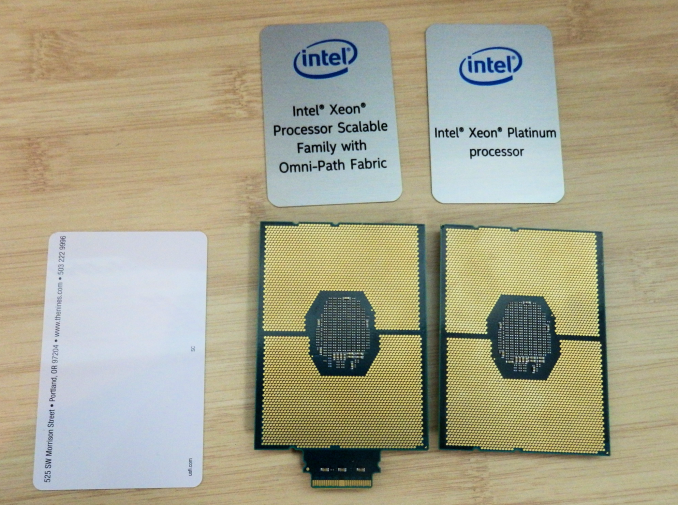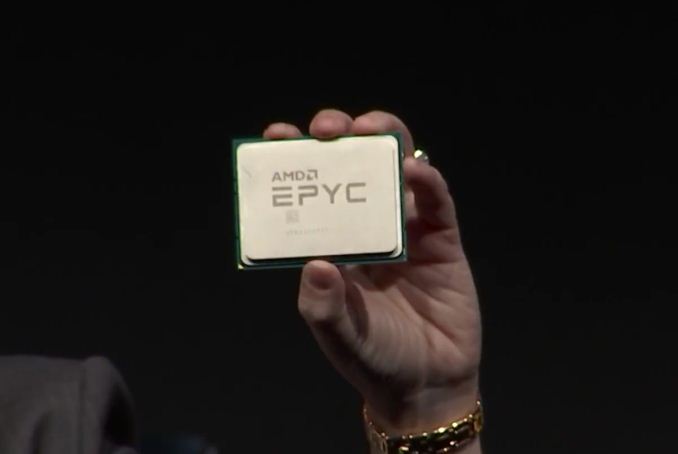Sizing Up Servers: Intel's Skylake-SP Xeon versus AMD's EPYC 7000 - The Server CPU Battle of the Decade?
by Johan De Gelas & Ian Cutress on July 11, 2017 12:15 PM EST- Posted in
- CPUs
- AMD
- Intel
- Xeon
- Enterprise
- Skylake
- Zen
- Naples
- Skylake-SP
- EPYC

This morning kicks off a very interesting time in the world of server-grade CPUs. Officially launching today is Intel's latest generation of Xeon processors, based on the "Skylake-SP" architecture. The heart of Intel's new Xeon Scalable Processor family, the "Purley" 100-series processors incorporate all of Intel's latest CPU and network fabric technology, not to mention a very large number of cores.
Meanwhile, a couple of weeks back AMD soft-launched their new EPYC 7000 series processors. Based on the company's Zen architecture and scaled up to server-grade I/O and core counts, EPYC represents an epic achievement for AMD, once again putting them into the running for competitive, high performance server CPUs after nearly half a decade gone. EPYC processors have begun shipping, and just in time for today's Xeon launch, we also have EPYC hardware in the lab to test.
Today's launch is a situation that neither company has been in for quite a while. Intel hasn't had serious competition in years, and AMD has't been able to compete. As a result, both companies are taking the other's actions very seriously.
In fact we could go on for much longer than our quip above in describing the rising tension at the headquarters of AMD and Intel. For the first time in 6 years (!), a credible alternative is available for the newly launched Xeon. Indeed, the new Xeon "Skylake-SP" is launching today, and the yardstick for it is not the previous Xeon (E5 version 4), but rather AMD's spanking new EPYC server CPU. Both CPUs are without a doubt very different: micro architecture, ISA extentions, memory subsystem, node topology... you name it. The end result is that once again we have the thrilling task of finding out how the processors compare and which applications their various trade-offs make sense.
The only similarity is that both server packages are huge. Above you see the two new Xeon packages –with and without an Omni-Path connector – both of which are as big as a keycard. And below you can see how one EPYC CPU fills the hand of AMD's CEO Dr. Lisa Su.
Both are 64 bit x86 CPUs, but that is where the similarities end. For those of you who have been reading Ian's articles closely, this is no surprise. The consumer-focused Skylake-X is the little brother of the newly launched Xeon "Purley", both of which are cut from the same cloth that is the Skylake-SP family. In a nutshell, the Skylake-SP family introduces the following new features:
- AVX-512 (Many different variants of the ISA extension are available)
- A 1 MB (instead of a 256 KB) L2-cache with a non-inclusive L3
- A mesh topology to connected the cores and L3-cache chunks together
Meanwhile AMD's latest EPYC Server CPU was launched a few weeks ago:
On the package are four silicon dies, each one containing the same 8-core silicon we saw in the AMD Ryzen processors. Each silicon die has two core complexes, each of four cores, and supports two memory channels, giving a total maximum of 32 cores and 8 memory channels on an EPYC processor. The dies are connected by AMD’s newest interconnect, the Infinity Fabric...
In the next pages, we will be discussing the impact of these architectural choices on server software.











219 Comments
View All Comments
deltaFx2 - Thursday, July 13, 2017 - link
"Can you mention one innovation from AMD that changed the world?" : None. But the same applies to Intel too, save, I suppose, the founders (Moore and Noyce) contributions to IC design back when they were at Fairchild/Shockley. That's not Intel's contribution. Computer Architecture/HPC? That's IBM. They invented the field along with others like CDC. Intel is an innovator in process technology, specifically manufacturing. Or used to be... others are catching up. That 3-yr lead that INtel loves to talk about is all but gone. So with that out of the way...AMD's contributions to x86 technology: x86-64, hypertransport, integrated memory controller, multicore, just to name a few. Intel copied all of them after being absolutely hammered by Opteron. Nehalem system architecture was a copy-paste of Opteron. It is to AMD's discredit that they ceded so much ground on the CPU microarchitecture since then with badly executed Bulldozer, but it was AMD that brought high-performance features to x86 server. Intel would've just loved to keep x86 on client and Itanium on server (remember that innovative atrocity?). Then there's a bunch on the GPU side (which INtel can't get right for love or money), but that came from an acquisition, so I won't count those.
"AMD exists because they are always inferior". Remember K8? It absolutely hammered intel until 2007. Remember Intel's shenanigans bribing the likes of Dell to not carry K8? Getting fined in the EU for antitrust behaviors and settling with AMD in 2010? Not much of a memory card on you, is there?
AMD gaining even 5-10% means two things for intel: Lower margins on all but the top end (Platinum) and a loss in market share. That's plain bad for the stock.
"Intel is a data center giant have head start have the resources...". Yes, they are giants in datacenter compute. 99% market share. Only way to go from there is down. Also, those acquisitions you're talking about? Only altera applies to the datacenter. Also, remember McAfee for an eye-watering $7.8 bn? How's that working out for them?
Shankar1962 - Wednesday, July 12, 2017 - link
Nvidia who have been ahead than Intel in AI should be the more competent threatHow much market share Intel loses depends on how they compete against Nvidia
Amd will probably gain 5% by selling products for cheap prices
Intel controls 98/99% share so it's inevitable to lose a few % as more players see the money potential but unless Intel loses to Nvidia there is annuphill battle for Qualcomm ARM.
HanSolo71 - Wednesday, July 12, 2017 - link
Could you guys create a Benchmark for Virtual Desktop Solutions? These AMD chips sound awesome for something like my Horizon View environment where I have hundreds of 2 core 4GB machines.Threska - Saturday, July 22, 2017 - link
For VDI wouldn't either an APU setup, or CPU+GPU be better?msroadkill612 - Wednesday, July 12, 2017 - link
Kudos to the authors. I imagine its gratifying to have stirred such healthy & voluminous debate :)milkod2001 - Thursday, July 13, 2017 - link
Are you guys still updating BENCH results? I cannot find there benchmark results for RYZEN CPUs when i want to compare them to others.Ian Cutress - Friday, July 14, 2017 - link
They've been there since the launchAMD (Zen) Ryzen 7 1800X:
http://www.anandtech.com/bench/product/1853
KKolev - Thursday, July 13, 2017 - link
I wonder if AMD'd EPYC CPU's can be overclocked. If so, the AMD EPYC 7351P would be very interesting indeed.uklio - Thursday, July 13, 2017 - link
How could you not do Cinebench results?! we need an answer!JohanAnandtech - Thursday, July 13, 2017 - link
I only do server benchmarks, Ian does workstation. Ian helped with the introduction, he will later conduct the workstation benchmarks.